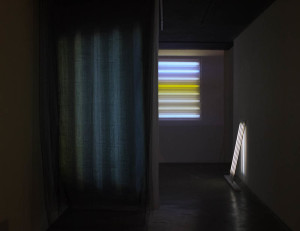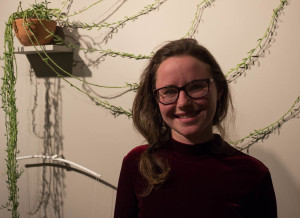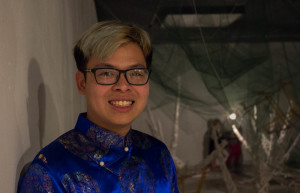Tags
Related Posts
Share This
Studio Arts BFA Senior Exhibitions Changes
On March 24, Santa Fe University of Art and Design’s Southwest Annex was transformed into a temporary art gallery for Phát Lê, Sarah Rothenthal and Chase Stafford, the first group of seniors in the graduating class of 2016. Their Studio Arts BFA Senior Thesis Exhibition was a huge success, attracting attention from students across departments, as well as members of the Santa Fe community. But, this opening senior thesis exhibition marks the beginning of a change in the way the Studio Arts senior shows are run.

Tom Miller, part of the Studio Arts faculty. Photo by Kyleigh Carter.
Up until this semester, the senior shows were held at the end of the year. Classes were split up into large groups and all the students in a single large group would present a small portion of their work at the same time. But now, the senior thesis exhibitions will be presented throughout the year—even trickling into the fall semester—in much smaller groups so each student will have more space to show their works.
Tom Miller, who teaches sculpture, video and foundations in the Studio Arts Department, is responsible for change.
“I wanted the students to be more responsible for their shows,” Miller says. “I wanted them to have more control over their shows and to come out of the program with a better understanding of all the parts that go into an exhibition.”
In order to do this, the gallery space was not the only thing that needed to change, but also the number of students who show together. Miller advocated for smaller groups of two or three students to have separate rooms in one space. This allows each student to control where the artwork is placed, with less interference with other members of the group.

Phat Le’s installation. Photo by Kyleigh Carter.
In addition to the smaller groups and larger gallery space, students also have a shorter amount of time to put up and take down their exhibitions.
“I think having to get in and out quickly is more realistic to most situations,” Miller says. “Galleries are a business. They don’t want people to come into their gallery and not have anything there for people look at for weeks.”
From now on, shows will go up on Thursdays and stay up for two weeks. Students in the next group will have 4 1/2 days to set up their exhibitions.
The main benefit to this, of course, depends on when a student is graduating. Early graduating students will have a better understanding of the time it takes to put on an exhibition.

Stafford’s installation. Photo by Kyleigh Carter.
“A lot of times it can be really disruptive to have a show,” Miller says. “Once a student has their show they can be at a bit of a loss as to what to do next, but I think it’s important for the students to know they’re going to be expected to continue working.”
For the students who graduate late, they’ll have the advantage of seeing the gallery space ahead of time and will have the opportunity to ask their colleagues about what challenge they encountered. Another benefit to this change is that it doesn’t allow students to hide their work because each student will have their own separate spaces to work on. Not allowing the students’ work to bleed together puts more emphasis on the work that is shown.
“I think that the effort put in by a student is going to be much clearer,” Miller states, cautiously, in response to a question on the impact. “If there are three artists in a group show and one didn’t work very hard, it’s going to be clear that they didn’t do their job.”

Sarah Rosenthal in front of her piece “Matilda”. Photo by Kyleigh Carter.
Miller wants this to be a permanent change. He believes that it’s an important and professional change that will provide the students with the opportunity to understand the amount of time and effort it takes to build an exhibition for a gallery in the art world. In the future, Miller plans to continue pushing for gallery improvements on the South West Annex. He hopes to put glass doors in front of the gallery so people can look in and see the exhibition that’s going on inside. He also wants to clean up the ceiling and get a more efficient lighting system installed in the building.
“I think it’s important for young artists to engage with working professionals and we do that through our internship programs, but we want our students to be able to go into those internship programs in a responsible and professional way,” Miller says. “I think that the gallery is a place where we can encourage and develop our students’ ability to work in those situations.”

Phat Le standing in front of his installation piece. Photo by Kyleigh Carter.
As for the first batch of students working under the new system, the were more focused on their exhibitions. Phát Lê‘s exhibit took up the largest space in the gallery and is inspired by an issue in the South Chinese Sea.
“This piece was very challenging to make but also very satisfying,” Lê says. “I wanted to make it an educational piece but, at the same time, not educational.”
Sarah Rothenthal, whose exhibit was more toward the front of the gallery, displayed a recent body of work that juxtaposed organic plant life and man-made material.

Studio arts major, Chase Stafford showed his installations at the show. Photo by Kyleigh Carter.
“I wanted people to start thinking differently about plants living in urban environments,” Rothenthal says. “We don’t pay as much attention to them as we need to.”
Chase Stafford’s exhibit was toward the back of the gallery and was a florescent light projection piece. After visiting the Chinati Foundations in Texas, he became interested in minimalist art as well as the effect of light and space on a viewer.
“When the viewer steps in front of the light they got off immediately,” Stafford says. “It forces the viewer to distinguish between fact and fiction.
The four BFA Senior Thesis Exhibitions will be on display in the South West Annex from March 24 to May 5. During the BFA Senior Thesis Exhibitions, the gallery will be open from 1-5 p.m., Wednesdays through Saturdays.






 Jackalope Magazine is the student magazine of Santa Fe University of Art and Design. Building on the interdisciplinary nature of our education, we aim to showcase the talent of our university and character of our city.
Jackalope Magazine is the student magazine of Santa Fe University of Art and Design. Building on the interdisciplinary nature of our education, we aim to showcase the talent of our university and character of our city.
Recent Comments